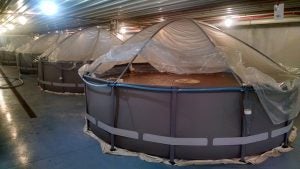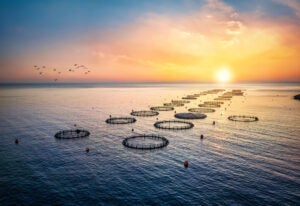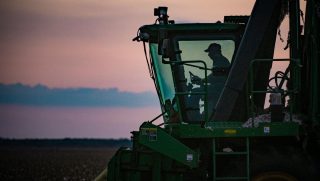There are many different types of farms out there, and some of the most interesting are fish farms! There is a growing demand for fish in the U.S., and in 2020, the estimated production of freshwater plus marine U.S. aquaculture was 658 million pounds, with a value of $1.5 billion.
The global demand for seafood is also on the rise. A 2020 study found that wild fish populations were increasing, especially in areas that are more intensively managed. This contrasts with thoughts that overfishing is becoming more common and a larger cause for concern. Still, overfishing is something that everyone should be conscious of — even with well-managed and increasing seafood populations, wild caught seafood can’t meet the increasing demand.
Luckily, fish farming (aka aquaculture) offers a sustainable solution.
Aquaculture is the breeding, rearing, and harvesting of aquatic plants and animals. It can take place in the ocean, or on land in tanks and ponds. In the United States, aquaculture mostly produces oysters, clams, mussels, shrimp, salmon, other freshwater and marine fish, as well as things like reptiles, aquatic plants, seaweeds and invertebrates like coral. Aquaculture doesn’t just provide food for us to eat: It also produces bait, supplies for aquariums and water gardens, and things that contribute to fisheries management.
Farmed seafood makes up half of the world’s seafood supply. In the United States, 24 percent of the value of seafood products come from aquaculture.

There’s a lot of different ways to raise fish, but many start in a hatchery. A hatchery is a mix of a laboratory and a farm, where fish and shellfish are spawned, then hatched and cared for. The aquatic animals stay at the hatchery until they’re large enough to move to a farm or be released into the wild. Some of the fish and shellfish hatched at hatcheries are released in the wild to restore populations of various species. Sometimes the reason for this is for continued recreational or commercial fishing, while other times it is to increase the population of ecologically important species.
But many fish go to a farm to be raised to full-size. There are several types of systems on fish farms. Fish can be raised in ponds, tanks, net pens, or raceways depending on the species and where it is raised. Most catfish are raised in ponds that are typically 10 acres or less with a depth of 5 to 10 feet. Net pens are enclosed, floating pens that are often used in marine aquaculture. This is done to monitor the fish and minimize interactions with the environment that could be harmful for the fish. Depending on the species being grown, aquaculture can even take place in an ocean or in inland freshwater.
Throughout the entire life cycle of aquatic animals, nutrition is extremely important. Aquaculture is actually one of the most efficient ways to convert animal feed into edible protein. Farmed fish are fed specialty diets that contain about 40 essential nutrients such as vitamins A, D, E, and C, choline, riboflavin, biotin, and niacin. Vitamin C, especially, is one of the most important nutrients for farmed fish.
Fish feed comes in two forms — floating and sinking. Most species eat floating food, but some prefer sinking food. Most fish food comes in pellets. The food a fish eats can vary by size, contents, nutrients, and type (floating or sinking) all depending on what species you are raising.

The final step to fish farming is processing. After being harvested, the aquatic animals are sent to a processing plant where they can be processed in a variety of ways, such as being filleted, flavored, cooked, frozen, and packaged for consumption. Seafood has some of the strictest food safety policies and requirements — farmed fish is highly regulated and definitely safe to eat.
Fish farming also supports jobs, particularly coastal communities and the people who work in raising fish, making fish food, processing seafood, and selling the products.
Aquaculture is also a sustainable way to produce protein. Not only can it meet the increasing demand for seafood, it has many other sustainability benefits. Shellfish (like oysters and clams) are natural filters that improve water quality. They also act as reefs, providing natural habitats for other aquatic animals. Aquaculture also has extremely strict environmental protections. These protections keep people and animals safe, protect water quality, and ensure that feed is efficiently converted into protein. Fish farms also recycle the water they use and work at hatcheries helps to balance populations of many different species.
Fish farms are a unique approach to agriculture that plays an important role in producing protein to feed a growing population. Most aquatic animals start out in hatcheries before moving to farms or being released into the wild. Fish farming offers a solution to overfishing and allows us to produce more seafood to enjoy at a lower cost and more sustainably than in the wild.
Aquaculture is growing and is continuing to be more sustainable to produce more food every day.
Michelle Miller, the Farm Babe, is a farmer, public speaker, and writer who has worked for years with row crops, beef cattle, and sheep. She believes education is key in bridging the gap between farmers and consumers.


